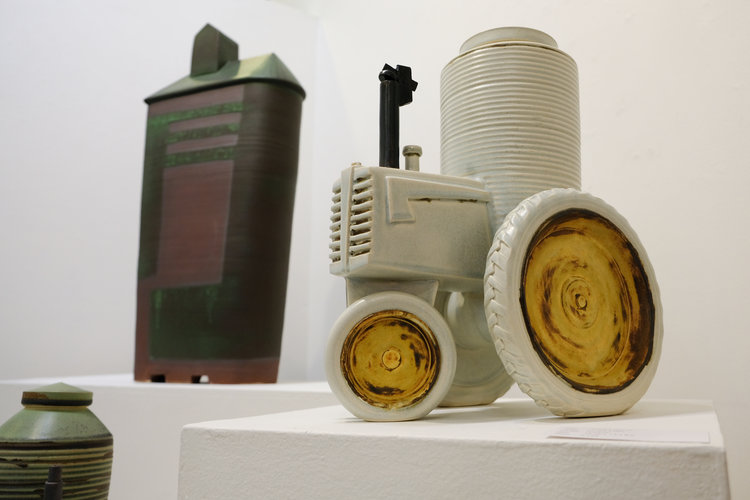
Q1: Why did you decide to work in ceramics?
ERNEST: I regarded clay as a creative outlet and small business.
MICHAEL: My dad was a carpenter and creative, and I grew up convinced of the importance of hands-on work. I have valued being a problem solver. When I was in college, I finally put a formal effort into training in art. Working with clay, specifically the potter's wheel at first, is very meditative. So ceramics satisfies my personal needs to be creative, work with my hands, and find sense of purpose.
Q2: How has your work developed over time?

ERNEST: My work has moved into a more personal expression of what I see and research.
MICHAEL: My first works were pottery. Functional pots, then more decorative pots. These moved towards sculptural pots. Now I primarily make representational sculptures via pottery-making techniques. Something I used to say when making pots was that the apparent function (bowl would hold soup, vase would hold flowers) of the piece was not as important to me as that the piece would functional as a sculpture. What I think I was trying to say, that I better articulate with my new sculptural work, is that the primary function of an object is not the only value of that object. While a bowl holds soup, it might also be beautiful, or provide an opportunity for friends to get together. A hammer drives a nail, but it can also be a symbol of my dad, or labor, or the idea of building something.
Q3: What's the most indispensable tool in your studio?
ERNEST: The kiln is the key tool besides clay. It's role in heating the finished pieces to 2,300 degrees Fahrenheit chemically transforms the clay into a permanent unchanging stone state.
MICHAEL: Pottery wheel. Not just for the forms I can make, buts its value in providing me a mental space to reorganize.
Q4: Is there an artist who has strongly influenced your work?

ERNEST: Recent influence comes from a Brazilian architect Oscar Niemeyer, the architectural paintings of Italian painter Christoph De Chirico, looking at early American folk pottery, and the Midwestern landscape. The never ending challenge is attempting to bring everything together.
MICHAEL: Jasper Johns. Some of his concepts about icons and symbols are relevant to what I do. Pete Voulkos, Bob Arneson-- their manners of handling the material. These artists influence my approach to my work more than they influence the choice of objects.
Q5: Can you tell us something noteworthy about your current work?

ERNEST: When looking at the forms of current work I notice how their shadows play across a tabletop or how placement engages a window. I'm interested in the work quietly becoming part of their new home and engaging with the visual space around it.
MICHAEL: Answered this a bit in 2. Much of my early pieces in this body of work were tool related, and fairly trompe l'oeil. While I still do those things, I have started adding objects that are not necessarily about "work". Trompe l'oeil is not paramount in this work. I want the pieces to lok like the idea of the object, like the picture in my mind, which can be fuzzy, out of scale, and different from the actual object. Also, some of the surfaces are very clearly ceramic and do not look like steel. I think that the old steel surface and the gloss white surfaces, for example, provide very different looks, but the audience may come to many of the same conclusions regardless of the surface. So the surface can offer different entry points to the work. The material is relevant; it is important to me that these pieces are ceramic, because the material provides the concurrent qualities of fragility and durability.
Ernest and Michael's two person show
Everyday Icons will be up until December 31st
